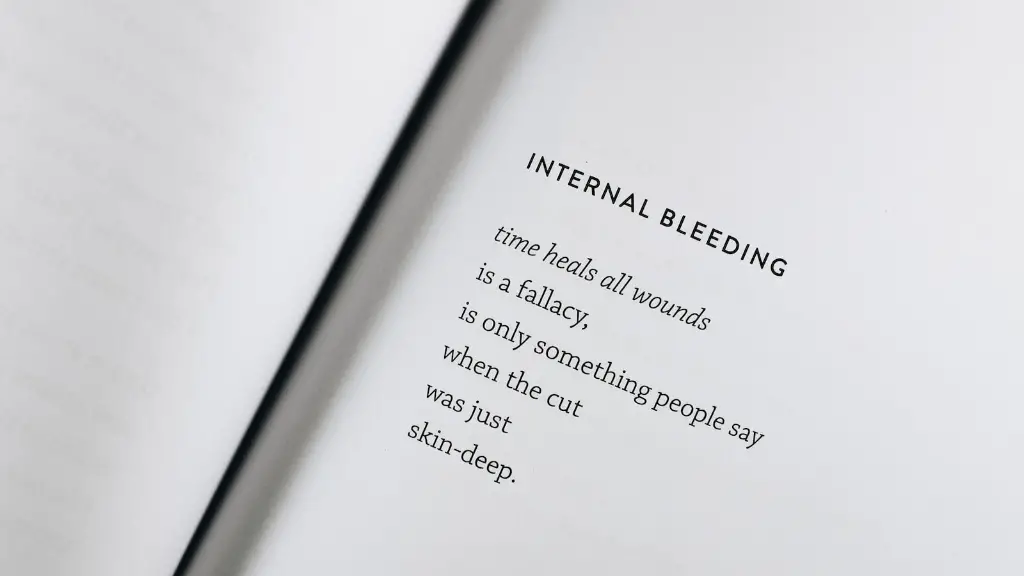What is Poetry Interpretation
Poetry interpretation is the process by which someone reads and understands a poem in order to draw meaningful connections and to interpret the poem’s elements. Poems can be interpreted many different ways and what one individual may think of a poem could be completely different than another person’s view on the same piece of text. In order to interpret a poem, one must carefully consider the structure, language, imagery, metaphors, and other creative techniques that the poet has employed. This allows the reader to draw connections to the poem’s themes, which helps them to interpret the poem’s meaning.
Poetry can be an effective way to express emotions and to convey deeper meanings than a simple statement. It allows a reader to interpret the poem and to discover their own personal connections and interpretations, allowing them to view the poem through their own perspective. With a clear understanding of the poem, a reader can more fully appreciate and interpret it. This can lead to a more meaningful experience, as one has a better understanding of the poem’s overall message.
There are many ways to interpret poetry. For example, the structure of the poem is one of the most important elements in understanding its meaning. The form can give clues as to the mood or desired outcome of the poem. The use of similes, metaphors, and allusions can also provide insight into the poem. Understanding the various literary devices used in the poem helps to interpret its purpose and meaning.
The language of the poem is also key to interpretation. Understanding the literal meaning of a word is the first step to understanding the poem. Additionally, the context in which a sentence or phrase is used can give further insight into the poem’s true message. Paying attention to words with strong connotations, such as loaded or vivid language, can provide insight into the poet’s intentions and feelings.
The imagery of the poem is a powerful tool in interpreting its true meaning. Imagery enables the reader to understand a poem on a deeper level and to find a connection to it. Imagery can be literal or figurative, and both forms play a part in the interpretation of a poem. By understanding the poem’s imagery, the reader can gain a better understanding of the poet’s thoughts and feelings.
Poetry interpretation is an essential part of understanding and appreciating the poem. By understanding the poem’s structure, language, and imagery, the reader can interpret the poem in order to gain a better understanding of its true message. This understanding can lead to deeper appreciation of the poem and can help one to interpret it on a personal level.
The Role of Sounds in Poetry Interpretation
The role of sounds in poetry interpretation is an important aspect that often gets overlooked. Poetry should be more than just words on a page – it should be an experience. One way to create that experience is to consider the sounds of the language being used in the poem. Sounds are an integral part of understanding poetry, and they can help to decipher the poem’s message in an innovative way.
By paying attention to the sounds in the poem, readers can discover hidden messages, feelings, and images that may not be conveyed through the words alone. Take, for example, the poem “April” by e. e. cummings. The poem features many forms of sound, from assonance to consonance and alliteration. Not only do these sounds evoke a certain feeling or emotion, but they can create a rhythm to the poem that enriches its meaning.
In poetry, the sound of words is just as important as their meaning. Assonance and alliteration can create a structure that allows the reader to move through the poem in a certain way and to make certain intuition leaps that can be difficult to make when the poem is read purely in terms of meaning. The sound of the language can also give emphasis to certain words or images, and even help to solidify the poem’s message.
Understanding sound can also give insight into a poem’s structure and help readers better interpret the poem’s true message. By listening to the poem and truly understanding the use of sound, readers can access a more complete understanding of the poem. This understanding can help to illuminate complex concepts and to better connect with the poem.
The role of sound in poetry is an integral part of interpretation. By listening to the poem and considering the various sounds used in the language, readers can gain a better understanding of the poet’s intent, and this can help to draw a connection between the reader and the poem.
How to Interpret a Poem
Analyzing and interpreting poetry can be overwhelming, especially if you are unfamiliar with the text. Some readers make the mistake of assuming that they can just read the poem and understand its message, when in reality they need to take the time to break down each poem step-by-step. Here are some tips for interpreting a poem.
First and foremost, look for the central theme of the poem. This can be done by looking for recurring images and metaphors, as these are strong indicators of the poem’s main idea. Identifying the tone, or the speaker’s attitude towards the theme, is also an important step. The tone may be happy, sad, angry, or anything in between.
Remember to look for sound devices such as alliteration, rhyme, and meter. These can be used to emphasize certain words and can give insight into the poet’s message. Additionally, look for literary devices such as metaphors, similes, and symbols, which can represent deeper meanings behind the poem.
Finally, look at the structure of the poem. Does it follow a set pattern? How does the poem open and close? What is the message at the end of the poem? Understanding the poem’s form can give insight into how the poet is attempting to convey the poem’s message.
Using these tips, one can learn how to interpret a poem. It is important to remember that interpretation is personal, and there is no right or wrong way to interpret a poem. By taking the time to carefully analyze the poem, readers can come to a better understanding of its true meaning.
The Process of Poetry Interpretation
The process of poetry interpretation is one of the most important steps in understanding a poem. It can be a complex process and requires patience and skill. There are several key steps in the process that must be followed in order to gain a thorough understanding of the poem’s message.
The first step is to read the poem carefully and thoughtfully. Take the time to read and re-read the poem, so that you can fully understand each line and what it is trying to convey. Pay close attention to any language that is unfamiliar to you, as this can often be key to understanding the poem’s meaning.
Once you have read the poem and established a general understanding of its meaning, it is time to look for deeper connections. Depending on the poem, this may require looking at the historical and social context of the poem. It may also involve exploring the poem’s structure, imagery, and sound devices.
Once the meaning of the poem has been established, it is important to consider the implications of the poem’s message. How does this poem reflect the poet’s personal beliefs and values? What is the poem’s overall message and purpose? These questions can help to form an even deeper understanding of the poem, and to draw connections between the poem and the reader’s own life.
The process of poetry interpretation is a nuanced and complex one. It is essential for readers to take the time to not just read the poem, but to think deeply about its message and purpose. Through this process, readers can gain a deeper understanding of the poem and its significance.
The Significance of Poetry Interpretation
Poetry interpretation is an essential tool in understanding and appreciating a poem. Not only does it allow readers to draw a personal connection to the poem, but it can also help them to uncover deeper interpretations that speak to the poem’s true meaning. By understanding the poem’s structure, language, and imagery, readers can gain new insight into the poem and a deeper understanding of its message.
Interpreting a poem is also a way to further appreciate the intricate craftsmanship of poetry. Poems are crafted in a special way, with the intention of conveying a particular message. By interpreting the poem, readers can gain a better understanding of the poet’s intentions and can appreciate the artistry of the work.
This appreciation leads to a greater respect for poetry and for poets. It allows readers to view poetry as more than just words on a page, but as an experience that can be shared and interpreted. Interpreting a poem is an enriching experience that can draw a deeper understanding out of the poem’s message.
Poetry interpretation is an important part of engaging with and understanding a poem. By taking the time to pay attention to its structure, language, imagery, and sound devices, readers can gain a deeper understanding of the poem and can develop their own personal connection to the work.
Creating a Personal Connection Through Poetry Interpretation
Interpreting poetry is an individual experience and can help the reader to create a personal connection to the poem. By understanding the poem’s structure and themes, readers can gain insight into the poet’s message and create a personal connection to the work.
For example, some poems may speak to the reader’s experience of loss and grief. Through interpreting the language and imagery used in the poem, readers can gain a deeper understanding of the poet’s feelings and can form an emotional connection to the work. This connection can help the reader to understand and feel connected to the poem in a more meaningful way.
By interpreting the poem, the reader can make their own personal connections to it. This connection can be incredibly powerful and can help the reader to relate to the poem on a deeper level. This can open up a dialogue between the reader and the poet and can help to draw new insights into the poem’s true meaning.
Creating a personal connection to a poem through poetry interpretation is an incredibly meaningful experience. It allows the reader to think more deeply about the poem, to gain a better understanding of its message, and to form an emotional connection to the work.
Interpreting Poetry for a Deeper Appreciation
Interpreting poetry is an important part of understanding and appreciating a work. By looking at the poem’s structure, language, and imagery, readers can gain a better understanding of the poet’s message and can draw personal connections to the poem. This deeper understanding can help to enrich the experience of reading a poem, and can open the door to new interpretations and insights.
Taking the time to understand a poem can also lead to a greater appreciation of the art of poetry. Through understanding a poem, readers can gain new insights into the craftsmanship of the work and can gain a better appreciation for the poet’s intentions. This appreciation can lead to a better understanding of poetry and can help to highlight its beauty and importance.
Interpreting a poem can be a difficult task. It requires patience and knowledge, and can often be intimidating for those without experience. However, taking the time to understand a poem can lead to great rewards. By understanding a poem, readers can gain a deeper appreciation for the poets and the art of poetry.





